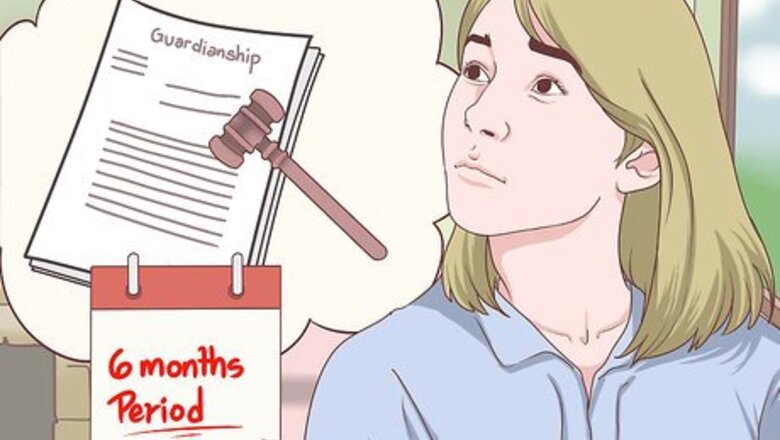
views
- After choosing your guardian and meeting up with them, speak to your lawyer to get expert advice.
- Make sure your letter includes all of the necessary information, like your guardian's powers, their length of time, their contact information, and an acceptance block.
- After reviewing your letter with your attorney, sign in front of a notary and create copies for your own records, your guardian, and all other necessary parties.
Preparing to Draft the Guardianship Letter
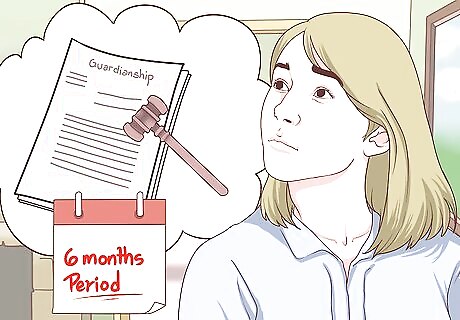
Check if your state allows guardianship letters. Not all states recognize guardianship letters. Instead, they require that even temporary custody issues be handled through the courts. The state of Maine, for example, requires parents to file papers with a court in order to seek a temporary guardianship. Some states limit informal arrangements, such as those made by letter, to a six month period in order to be effective. Find and read your state’s statute on domestic relations or child custody. To find your state statute, type the name of your state into a search engine along with the words “temporary guardianship,” “guardianship,” or “domestic relations.”

Consider meeting with a lawyer. You can meet with a family law attorney to check whether your state allows guardianship letters. An experienced family lawyer can also help you draft the letter or come up with a list of potential guardians. To find a family law attorney, you can contact your state’s bar association, which should run a referral program. If costs are a concern, be aware that many attorneys now offer “unbundled legal” services. Under this arrangement, the lawyer will perform discrete tasks (such as offering advice or drafting a guardianship letter). By paying for only limited services, you can lower the cost of legal representation.

Come up with a list of guardians. The guardian should be someone you know well and trust completely. The guardian should also be familiar to the children. Ideally, a temporary guardian should live near you so that your children’s lives will not be unduly disrupted. Many people consider family and close friends as first choices to act as guardians. You should also consider the parents of your children’s friends. They know your child and, if they live in the same area, can transport your child to school quite easily. Be sure to talk to your children as well. If they are old enough, they may have a preference for who they want to stay with.

Meet with the guardian. Before drafting the guardianship letter, you should meet with the temporary guardian and talk about the guardianship. Discuss expectations and any limitations. Be sure to share a copy of your draft with the guardian before finalizing it.
Drafting the Guardianship Letter

Insert preliminary information. Open a blank word document and type the permanent address of the parents at the top of the letter. Align the address to the left-hand margin in a block. Then, you should also include the date two lines down from your address. For the sake of simplicity, make sure that it is the date when the letter will be signed. Next, type the address of the guardian two lines below the date. Align it to the left, just as you did with your own address.
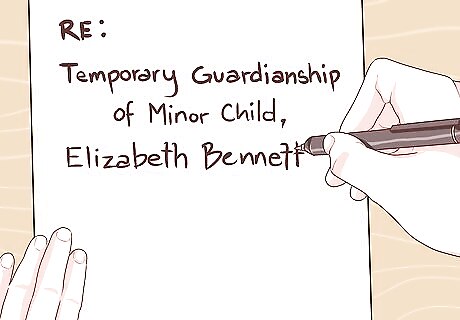
Include the subject heading of the letter. Two lines beneath the guardian’s address, you should insert the subject heading of the letter. For example, type “RE: Temporary Guardianship of Minor Child, Elizabeth Bennett.”
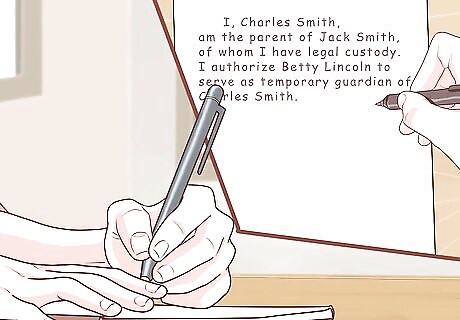
Draft the body of the letter. The first paragraph of the body of the letter should name your children and state that you have custody of them. You should then state that you are giving temporary custody to the temporary guardian, whose name you should also include. For example, you can type, “I, Charles Smith, am the parent of Jack Smith, of whom I have legal custody. I authorize Betty Lincoln to serve as temporary guardian of Charles Smith.” If there are two parents, then type, “We, Charles Smith and Evelyn Smith, are the parents and legal guardians of Jack Smith. We authorize Betty Lincoln to serve as temporary guardian of Charles Smith.”
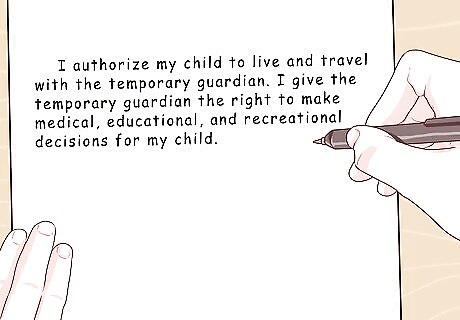
Describe the powers. You should state what powers you are giving to the guardian, such as the ability to make educational, recreational, or medical decisions. It is best to be as inclusive as possible. For example, you may write: “I authorize my child to live and travel with the temporary guardian. I give the temporary guardian the right to make medical, educational, and recreational decisions for my child.” You might choose to limit the powers. For example, you may not want to grant the temporary guardian the power to make any and all medical decisions. Instead, you can specify what medical decisions the temporary guardian can make. You might write: “I grant the temporary guardian power to authorize medical care for my child, such as medical examinations, X-rays, blood tests, and emergency treatment.” By limiting the information, you can assure that you will be contacted for approval for other treatments.
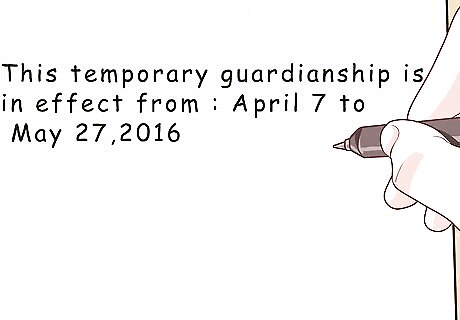
State the duration of the temporary guardianship. You should specify the dates during which the temporary guardianship is active. For example, you can type, “Duration: This temporary guardianship is in effect from [start date] to [end date].”
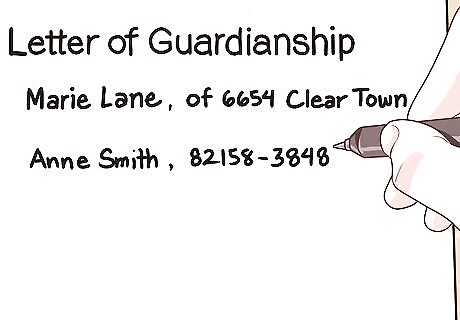
Include contact information. You should include information about where you will be and how to contact you. You could write, for example, the address where you will be staying and any phone number. Also provide contact information for professional providers. You should include a list of any professional providers, such as doctors and dentists. Include their addresses and telephone numbers. Also include information about insurance, such as policy numbers and the name of the insured parent.

Include information about your children and the guardian. You should list the name of each child and then include the child’s permanent address, phone number, and date of birth. Underneath the information on your children, include information about the temporary guardian: name, address, phone number, email, and relationship to the child. You also might want to include the guardian’s driver’s license number. With this information, the person receiving a copy of the guardianship letter can check that the person with the letter is, in fact, the temporary guardian.
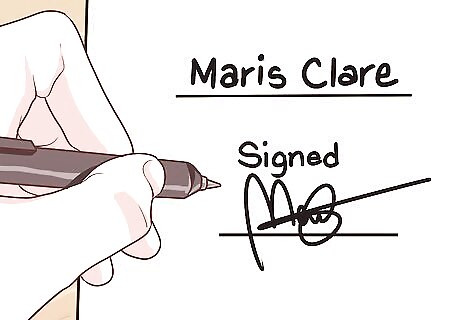
Add a signature block. Skip five lines after the body of the letter to give room for signatures. Type each parent’s legal name at the bottom of that space. If both parents are signing, then the signature blocks can either be side-by-side or one can be above the other.

Insert an acceptance block. Two lines below the parent’s signatures, type the following statement: “I, [guardian’s name], accept guardianship of [children’s names] in accordance with the letter above.” Two lines below this acceptance, enter the date that the guardian signs the acceptance. Then skip five lines down to leave room for the guardian’s signature.
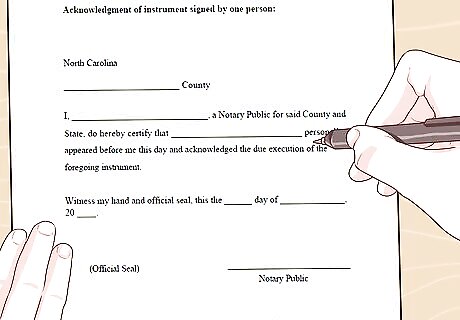
Include a notary block. Many states require that a guardianship letter be signed in front of a notary. Search the internet for a notary block acceptable for your state and copy it at the bottom of the page.
Finalizing the Process

Have an attorney review. If you did not get advice from a lawyer before drafting the letter, you may want to consider having an attorney review your draft to see if you missed anything. Give the attorney a week to review, if possible.

Sign in front of a notary. Do not sign the letter until you appear in front of a notary. The guardian should also sign in front of a notary although you do not have to sign at the same time. Be sure to bring sufficient personal identification when you appear before the notary. Typically, a valid driver’s license or passport should suffice. Notaries can be found at most banks, courthouses, and city clerk’s offices. You can also search for notaries by visiting your state’s Secretary of State website, which should have a list of licensed notaries or a search engine you can use.
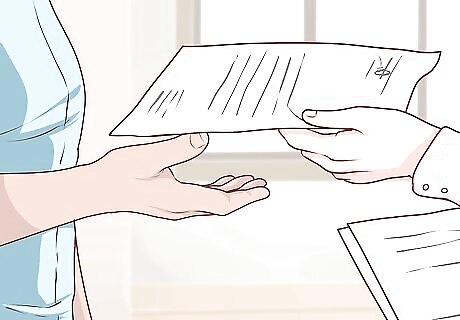
Make copies and distribute. You should make at least one copy for your own records. Also make copies for each guardian and additional copies in case the guardian needs to present a copy of the letter while you are away. Distribute to necessary parties. Copies of the letter should be distributed to all professionals involved with your children, such as schools and doctors.

Revise if necessary. You may be out of the country on more than one occasion. You will need a new guardianship letter for each occasion. Use your initial letter as a template and adjust accordingly. You will need to change the dates of the guardianship. You might also need to update the name of the guardian as well as medical care information. Each new letter must be signed and notarized as well.




















Comments
0 comment